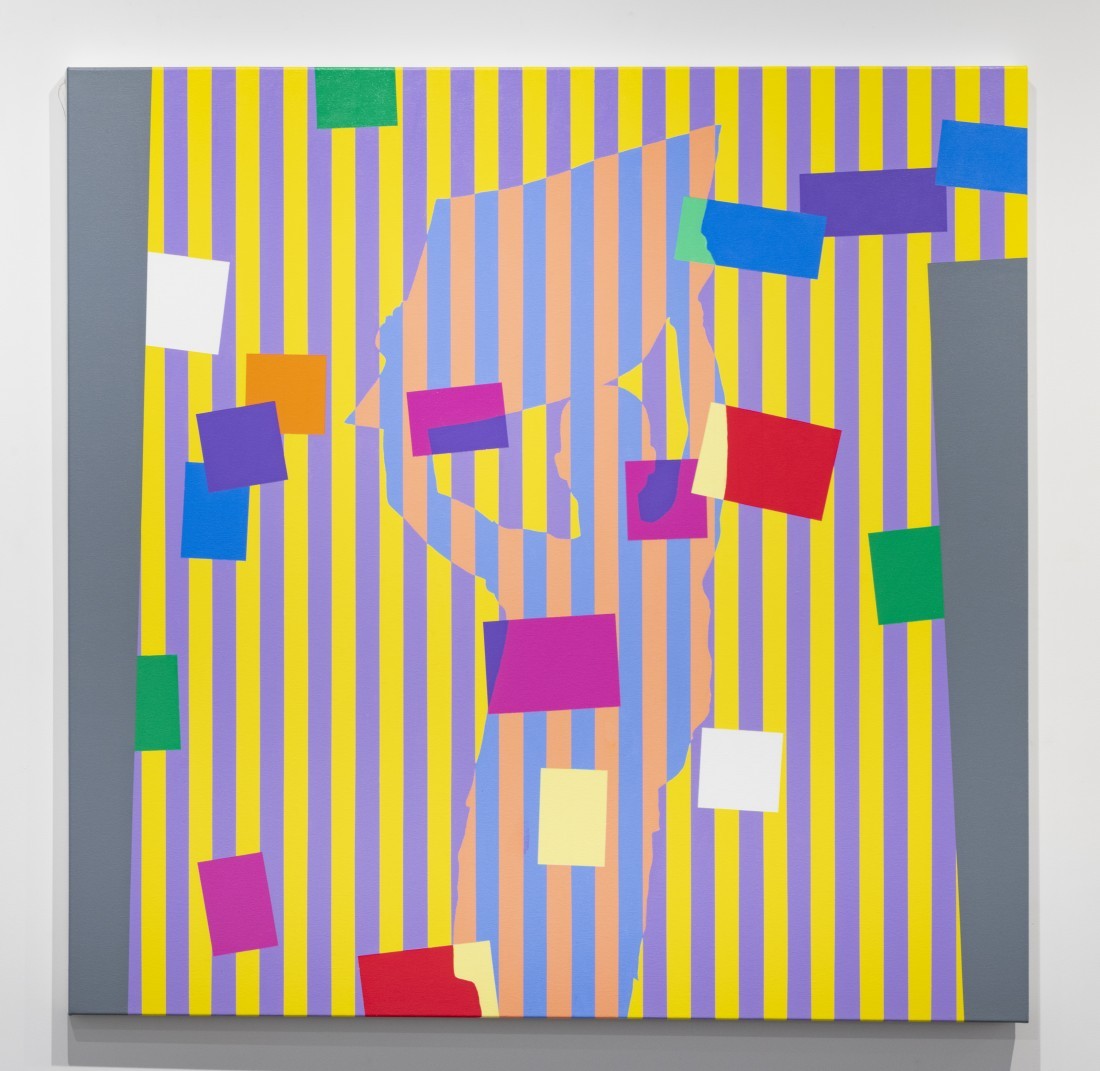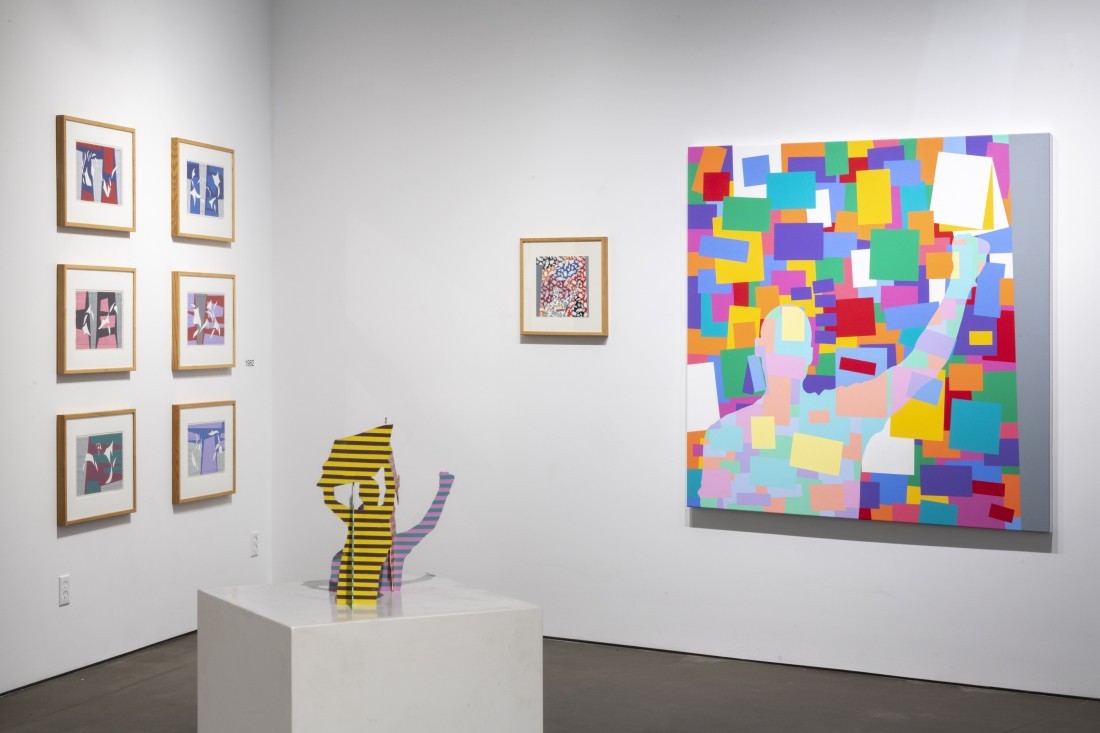Randall Anderson
Success as an artist is elusive, and, when attained, fleeting. The career of an artist who actually stays in the game for decades therefore bears close examination—sometimes by the artist himself. In the case of Randall Anderson’s recent exhibition, “New Work ….. from the 80s,” the artist casts his attention backward by four decades, revisiting old images and ideas in a new body of work.
Exhibited at Produit Rien, an independent space opened last year by Montreal artists Karen Trask and Paul Litherland, “New Work” consists of approximately two dozen pieces, some from the 1980s, some brand new. The human figures presented in these works, finding themselves in the shadow of forces greater than themselves, respond with dance, celebration, maybe even revolution.

Randall Anderson, Look, 2021, acrylic on canvas, 60 x 60 inches. Photo: Paul Litherland.
A series of three untitled maquettes from 1984, rendered in acrylic and colour Xerox copy on cardboard, depict human figures: a man and a woman menaced by a half-dozen falling bombs, or a soldier levelling his rifle—a silhouette appropriated, in fact, from a news media image of the assassination of Egyptian president Anwar Sadat. In a striking gesture, the linerboard in this piece is cut away to reveal the raw, brown corrugation beneath. A third maquette depicts a circle of dancers derived from the famous La Danse by Matisse (who also worked in cardboard).
Various elements in these images—the dancers, the bombs— are filled in with colour Xerox, wallpaper-style, repeating patterns depicting a veritable tide of consumer household objects: automobiles, television sets, flush toilets, telephones, electric kettles. Today these images evoke dingbat font characters but, at the time when Anderson created them, may have suggested Letraset transfers.
Nearby are six small paintings from 1982, which feature restrained colour palettes (including prominent blocky, grey shapes) in acrylic on paper. Atop geometrical structures criss-crossed with fine vertical and horizontal lines, white shapes are outlined in arrays that somehow recall, subtly and comedically, Matisse’s dancers.
In many of the older works, the subject figures exist amid repressive political agents (bombs, assassins) and economic systems (consumerism). However, although Anderson’s newer works, all 2021, evoke similar themes, they also evince a certain shift in attitude.

Randall Anderson, installation view showing Listen, both painting and collage, and six acrylic paintings on paper from 1982, 9 x 13.5 inches. Foreground: Maquette for Model for a Monument, acrylic on matt board, 12 x 8 x 9 inches. Photo: Paul Litherland.
In the new works—four large, five-foot-square paintings with four corresponding 11-inch-square collages—we again encounter outlined human figures seemingly appropriated from news photos: a flag-waving man in a hat, a woman and a man with linked hands held aloft, figures holding placards and raising fists in solidarity with something or someone. Anderson’s wallpaper pattern also makes a reappearance— in the collages though not the paintings—as the human figures are partially obscured behind a near-whiteout of consumer goods.
In the small collages, the colour schemes seem somehow dampened, calculated not to complement each other—they do not “go together.” In contrast, the colours in the large paintings are brighter, more complementary and harmonious, even celebratory. Happily, the figures in the paintings also seem less encumbered, more optimistic than those in the collages, their victory celebrations undeterred by torrents of consumer objects. And in addition to the bolder, brighter colour combinations, the backgrounds of Anderson’s paintings use geometric forms suggestive of carnival tents: checkers, stripes, or clusters of coloured squares and rectangles reminiscent of placards in a crowd, or possibly even Post-it Notes. Like the rest of the painting, the celebratory figures are composed of these coloured blocks, their silhouettes distinguished from their surroundings via a subtle colour scheme. In all these new works, nonetheless, the blocky greys from Anderson’s 1982 paintings reappear, intruding along the edges and throwing off presumptions of order or alignment.
A student of painting under Molinari at Concordia, and of critical theory under Ian Wallace at Emily Carr, Anderson has aimed at reconciling disparate approaches, not always an easy task. He has shown work in dozens of exhibitions, sometimes in unusual circumstances such as hauling sculptures on trucks about the streets of Toronto or even across the continent. Given his eclectic range, Anderson’s emphasis on painting, in his new works, may be surprising; and in person he admits to feeling sheepish about it. Paintings, he says, are “objects of consumption in an exchange economy” and thus are “not to be trusted.”
Anderson’s new series is capped by a sculpture—a motley little piece on a plinth, mid-chamber, titled Maquette for a Model for a Monument (Slider). Here, the bold figures from the paintings and collages, saluting and waving flags, are cut from particolour- striped matboard and slotted together in a three-dimensional array. A party, a revolution? Both?
The high colour, the apparent optimism of this small piece— indeed, of Anderson’s new works in general—are odd for someone whose relationship to his own practice is sometimes ambivalent. His figures seem to demand answers to some central questions: Where is the victory in art, in being an artist? Is such a victory even to be hoped for?
It may be the case that we, as people and as artists, don’t change so much over time. We experiment with new mediums, play with new themes, but our underlying concerns remain consistent— such as Anderson’s vision of the individual in the grip of greater socio-economic forces. What does not remain consistent, however, is the world around us. And in the art world, the landscape has certainly changed.
The art school and the university are closer than ever, minting hundreds of bushy-tailed MFAs seeking fortune in a cold world. In these schools, artists harness themselves to the corporate research university’s credential-ing requirements and the ideal worlds of critical theory in the hope, often in vain, of a coveted teaching position and plentiful SSHRC funding. The artist-run institutions, once radical, are mostly fancy little galleries now—as fancy, at least, as their arts-council support permits. Higher up on the ladder, the earlier commercial structures have yielded to a sky-high investment market, a game between one-percenter billionaire financiers and their art-world counterparts, those fortunate but few one-percenter artists. In essence, those powerful socio-economic forces that Anderson has warned us about for decades are today in the driver’s seat.
Painting has long been disdained by the cerebral, politically minded artist set as an object-based, commercial and therefore regressive enterprise, but that view seems naïve today. Yet even 40 years on, Anderson, arguably a member of that set, cannot shake his suspicion toward painting. Nonetheless, he’s going ahead with it. Against the current art-world backdrop, frankly, the goal of making a living as a working painter seems basically honest. Maybe even a little radical. ❚
“Randall Anderson, New Work ….. from the 80s” was exhibited at Produit Rien, Montreal, Quebec, from September 7, 2021, to September 13, 2021.
Edwin Janzen is a visual artist living in Montreal and working in installation, digital printmaking, video, drawing, artist books and other media.

